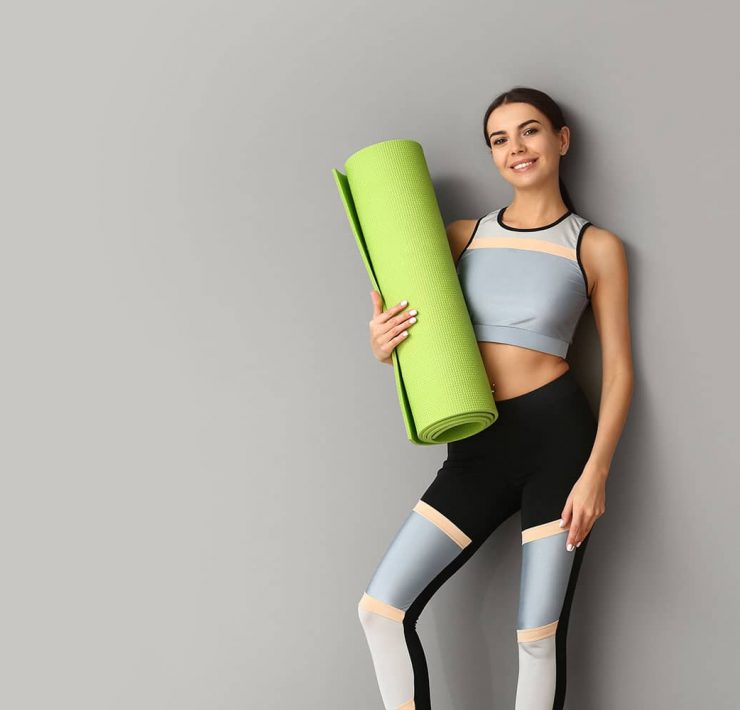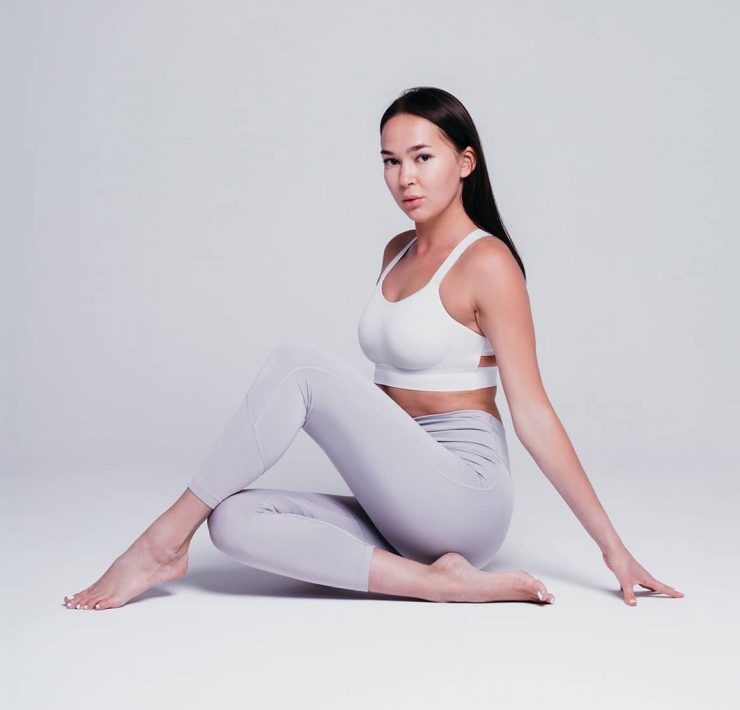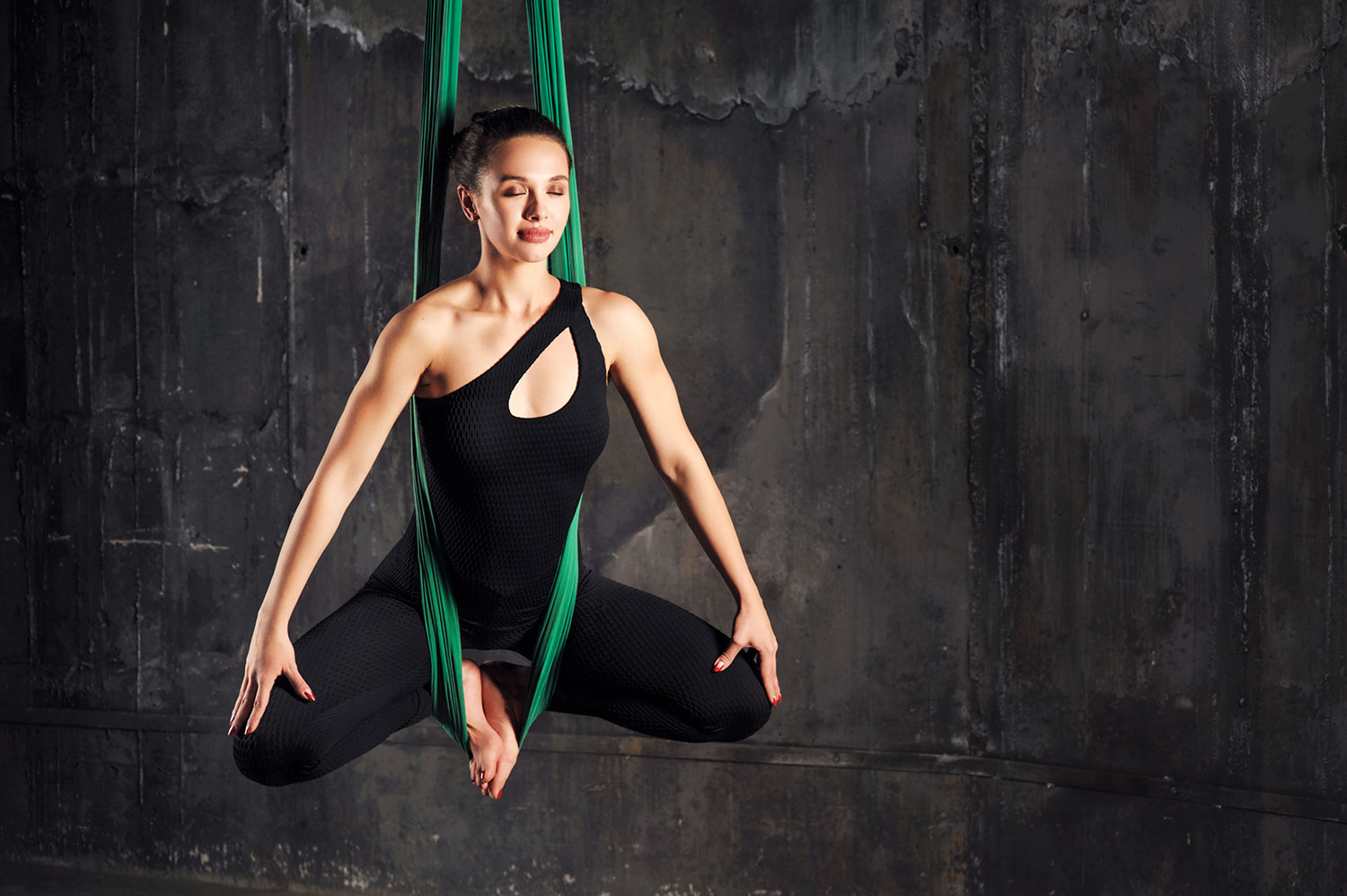
Lauren Howard holds a master certification in reiki, or energy…
ex it offers a wide range of benefits. Some of these benefits include mood. Other benefits are improvements in the lymphatic and digestive systems. There are even claims that these movements help stimulate the mind. All because of the upside-down maneuvers.
Are acrobats an interest of yours? Then you’re in luck as aerial yoga provides a workout that delivers in strength exercises and fun.
What Is Yoga Trapeze?
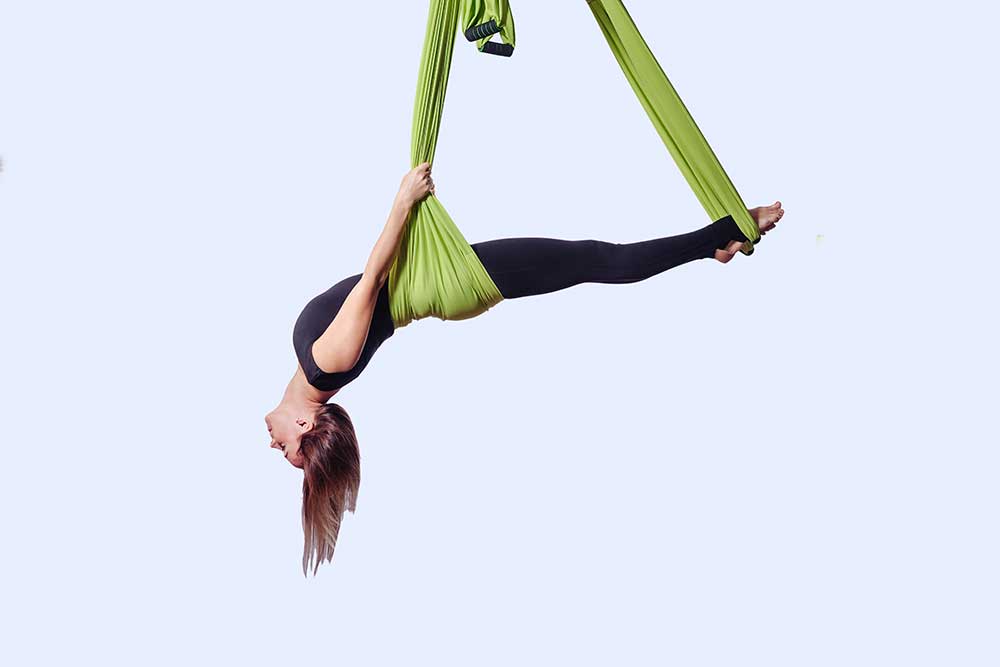
Although a lot of the movements share a commonality with aerial silks, these classes are very different. Aerial silks and their performances are by very experienced individuals. This is because they are much higher off the ground than the hammocks used for trapezes. The idea of yoga trapeze is to suspend the body enough to use gravity to help the body realign itself. This can also help take away some of the body weight. Then the hammocks help to support and achieve the best stretch possible.
What to Expect in a Yoga Trapeze Classroom

Here’s what to expect when entering a classroom for yoga trapeze. A room is full of hammocks hanging from the ceiling over yoga mats. Once students select their hammock, they begin moving until they’re in full suspension. That is when they will begin lunges and twists. You will also see a mixture of yoga poses and some Pilate-inspired moves.
At first, the fabric may seem intimidating. In fact, some individuals fear that it is going to break during some of the moves. But, rest assured, this fabric is a durable material and is triple-stitched. Most trapeze hammocks use the same material as parachutes. They have also tested their products to support up to 350 pounds. Depending on the yoga trapeze you’re interested in, check into the product information of what they offer. Some may offer a thicker material and a different way to hang the hammock in your home.
There are yoga trapezes with handles that can help for added support through the moves. Others come without handles. Each can hold up to 350 pounds. It’s essential to do research on which fits into your home, budget, and needs. What is most important when starting trapeze yoga is with the proper installation. This will help keep you staying focused in the moves giving you the most confidence in the activity.
Whether you want to start in a classroom setting, or setting up the hammock in the comforts of your home. You will want to begin within an environment you’re most comfortable in. Remember to take deep breaths and go at your own pace.
If you’re uncomfortable with something, then don’t worry about doing it. There’s plenty of encouragement from the other students that started where you are. Enjoy the movements and ensure that you can meet proper form before moving onto the next.
What Are the Benefits of Yoga Trapeze?

Aside from the fun, there are benefits for the inversion aspect of the hammocks and moves. Some say that trapeze yoga helps to better the mind as well as the muscles of the body. Incorporating a yoga trapeze can help benefit the most novice of yogi’s to the most practiced.
- Strengthens Muscles: While suspended in the air, it isn’t necessary to hold yourself up. This is an opportunity to tackle some more difficult muscles and work to strengthen.
- Practice Inversions:The benefits to inversion are plenty. It betters the circulation in the body and calms the body. It can also help improve digestion. With inversions, you’re manipulating gravity to help the body realign itself.
- Increased Stretches: Suspension enables students to feel the stretch in its entirety. Especially in backbends. Backbends can be challenging for some as it can elicit anxiety. Still, when practicing, you’ll be able to perform similar poses. These poses will help you achieve similar results.
- Improves Core: This one may seem obvious, but the core is working hard to balance the body in its suspension. This is a way to build the abdominal muscles and a more efficient way of engaging the core. Yoga trapeze helps to cut mundane exercises and replace them with some fun core workouts.
- Reduces Discomfort: Gravity works for us, and sometimes against us. At least that’s what our hips and back tell us. Sometimes our bodies need extra support to hold us up and keep our spine aligned. Yoga trapeze has gained a lot of popularity because of its unique approach to help reduce back pain.
- Increases Mood: In the movements where the body is hanging upside down. This helps send oxygen to the brain. As it contributes to releasing hormones that give off happier signals.
Not to mention one of the most clear benefits during these workouts is having a good time!
What Are Some Beginning Postures in Yoga Trapeze?
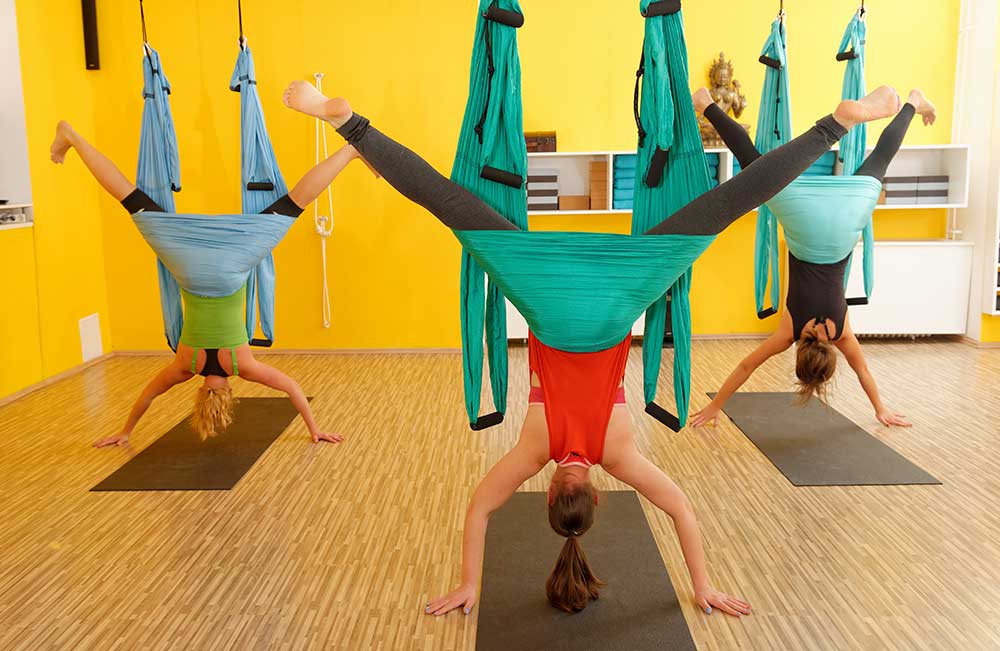
Aerial yoga can seem intimidating when your body is in the air. But, many movements are very fluid and easy to get started. Consider the following moves for beginners.
- Lay Back: It’s the most tempting posture but to lie on the back in the hammock and allow it to swing. Putting the arms out to the side, this posture helps to open the chest and shoulders. While also targeting the core and reducing stress and tension that improve posture.
- Chair Position: This posture is familiar, as it requires you to sink as if you’re sitting into a chair. Keep the wing underneath the armpits to allow for a deeper stretch. Rest hands on the thighs. This stretch can help release compression through the vertebrae.
- Hammock Plank: To encourage building strength, rest the top of the feet onto the hammock. From here, place the hands underneath the shoulders to enter the plank position. This move enables the core to be engaging. The posture allows for the shoulders, legs, wrists, and spine to increase in strength. It’s something that will work the whole body.
- Shoulder Expansion: This pose requires the hammock to wrap around the wrists and press palms forward. This stretch shoots through the shoulders and spine and helps to relieve any pain in the lower back.
- Gravity Inversion: Envelop the hips in the hammock and lean backward, straightening the legs out in front of you as you roll back over the hammock. Allow the hands to stretch the arms out and move them to either direction, almost as if you’re mirroring a starfish.
Any of these postures will help get you familiar with the hammock. They will also help get you familiar with the transition into each move.
What Are the Best Trapeze Swings?

There are a lot of yoga trapeze swings on the market. Some come in a variety of colors and others that are ready to hang out of the box. Here are some of the best-rated yoga swings on the market and some of their perks.
- YOGABODY Yoga Trapeze Swing: If you’re looking for a swing that will offer the same experience you’ve had in the classroom, then look no further! You can have the very same yoga trapeze that they use in their classrooms in your home. This yoga trapeze comes with an easy video tutorial and is back with a warranty that lasts over ten years.
- Aerial Yoga Inversion Hammock: This yoga swing comes in many colors and has padded handles. These handles help transition into different movements and is triple-stitched to ensure durability.
- Yoga4You Aerial Yoga Swing: This swing’s silk nylon fabric is beautiful. It is also durable as it bears the weight of up to 600 lbs. This yoga swing comes with a digital guide to help show how to install the swing. It will also show you what poses to get started. All at an affordable price.
- Aum Active Aerial Yoga Hammock: This hammock comes in many colors. All from beautiful aerial silk. Great for beginners or more advanced in trapeze yoga. Although affordable, please note that the mounting ring is not included in this sale.
- HealthyModelLife Active Silk Aerial Yoga Swing: This swing includes the complete hardware kit. This can help take the mess out of figuring out how to hang the hammock. This type doesn’t have handles, but only the soft touch of its silk and stretchy material.
Is Yoga Trapeze Right for Me?
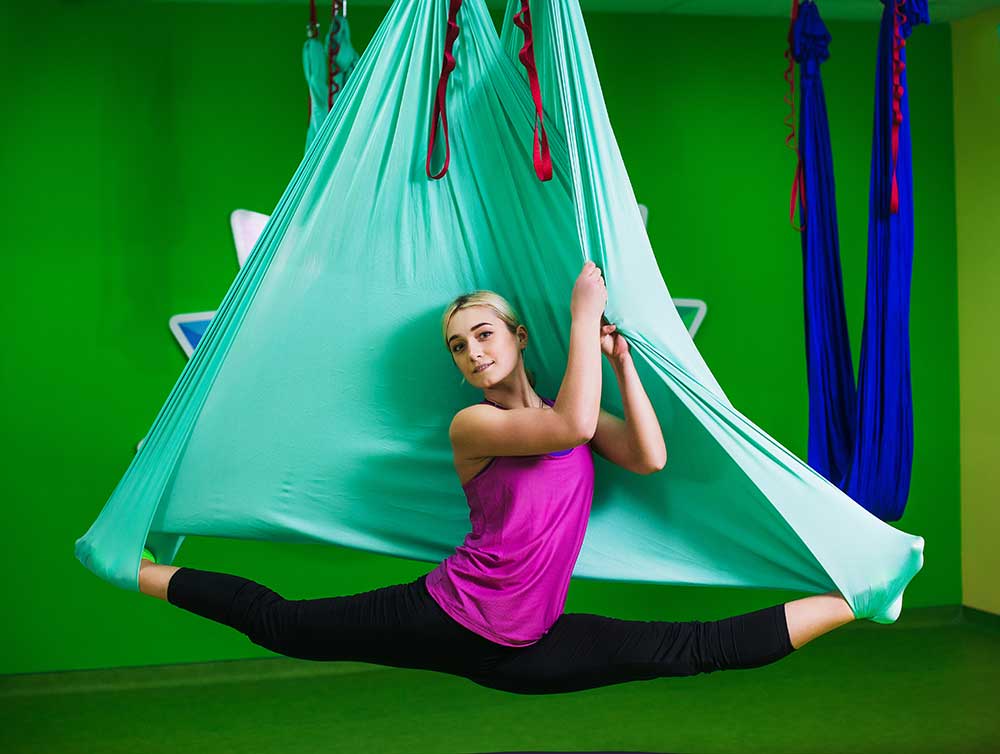
A yoga trapeze can seem intimidating at first. It’s unfamiliar and entrusts our bodyweight onto a hammock fabric. Yet with the security of proper installation within our home’s comforts, there is a list of reasons to consider yoga trapeze. Its benefits link to increased mood and decreasing discomfort while working against gravity. All to meet a better and more effective stretch. Individuals who struggle with flexibility, may consider adding this to their workout. A yoga trapeze may be a fun and creative way to elevate a workout routine.
What's Your Reaction?
Lauren Howard holds a master certification in reiki, or energy healing, and has been practicing yoga for over 20 years. She began freelance writing as a means of spreading her truth and knowledge with a broader audience.









